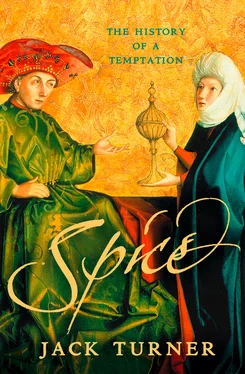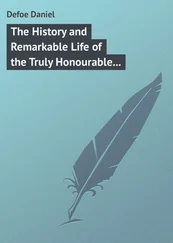Everywhere they went, on this and on subsequent voyages, it was the same story. Yet before long the excuses started to wear a little thin, and in due course Columbus’s inability to make good his promises of gold and spices would contribute to the loss of his credibility. On each of his four voyages to the Caribbean he was compelled to turn for home with little more than paltry samples of gold and his indifferent ‘spices’, just enough to save him from ridicule, leaving others behind to carry on the search, each time with his excuses at the ready. Ferdinand’s patience with his dreamy admiral wore thin, as did the patience of those who served under him. An anonymous memo of 1496 stated what was becoming increasingly clear to all but Columbus: that the islands’ so-called spices were worthless. One who had his feet more firmly planted on the ground, and perhaps the first to appreciate the realities of the situation, was a crewmember of the second voyage, Michele de Cuneo. Writing from the island of Isabella during the second voyage, on 20 January 1494, he was quick to accommodate himself to a spice-free America. When an expedition was dispatched into the hinterland, returning with two Indians, their failure to find any spices was compensated for by their samples of gold: ‘All of us made merry, not caring any longer about any sort of spicery but only of this blessed gold.’ And indeed gold was where the future lay.
Even now, however, and for decades after, the hope of American spices lingered on. As late as 1518, Bartolomé de las Casas was still prepared to believe that New Spain was ‘very good’ for ginger, cloves and pepper. Remarkably, Hernán Cortés, the conqueror of the Aztecs, was perturbed by America’s elusive spices – this in spite of his having delivered a quite colossal fortune into the royal treasury from the conquered empire of Montezuma. In a string of letters to the king he repeatedly promised to find a new route to the Spice Islands, and offered a string of shamefaced apologies for his failure to deliver any cloves or nutmeg in the treasure ships now regularly sailing back to Castile. His men, he pleaded, were still looking. In his fifth letter of 1526, like Columbus before him, he asked for a little forbearance. Given time, he promises, ‘I will undertake to discover a route to the Spice Islands and many others … if this should not prove to be so, Your Majesty may punish me as one who does not tell his king the truth.’
Fortunately for Cortés his bluff was not called. He found no spices, but neither was he punished. For several decades more the conquistadors kept looking, yet all, like Columbus, found themselves chasing a will-of-the-wisp. In the south of the continent, Gonzalo Pizarro set off on a deluded, disastrous quest for cinnamon, plunging from the icy heights of the Peruvian altiplano into the Amazonian jungle, half a planet away from the real thing. Others sailed north, searching for nutmeg and a north-west passage deep in the icy wastes of the Canadian backlands. In due course the New World garnered new dreams and new fortunes from gold and silver; after, there was sugar, fur, cotton, cod and slaves. It was not for well over a hundred years after Columbus first looked that the myth of America’s spices was finally dispelled.
And yet the search was not quite the failure it seemed at the time. The Central American jungle yielded vanilla, and Jamaica allspice – its hybrid taste and pepper-like appearance the source of much confusion. There were, besides, other vegetal riches ripe for the plucking: tobacco, maize, potatoes, tomatoes, chocolate. Columbus himself brought back pineapple and cassava. Centuries later, Asian spices were eventually introduced to the Americas, with such success that Grenada is now a major producer of nutmeg; the island republic features a nutmeg on its flag. And even Columbus, his delusions and false dawns notwithstanding, found one reasonable approximation to a spice. In his log for 15 January 1492 he writes of Hispaniola that ‘there is also plenty of aji, which is their pepper, which is more valuable than [black] pepper, and all the people eat nothing else, it being very wholesome. Fifty caravels might be annually loaded with it [from Hispaniola].’ Peter Martyr, the Italian humanist at the Spanish court, noted that five grains of the new plant brought back by Columbus were hotter and more flavourful than twenty grains of Malabar pepper. Columbus himself was taken aback by its heat, reporting to the king and queen (like many an unwary newcomer since) that he found Caribbean food ‘extremely hot’. The natives seemed to put their incendiary pepper in everything.
Not even such a dreamer as Columbus could have foreseen the future success of his ‘ aji ’: it was, of course, the chili, and it was growing wild all over Spain’s new possessions. Within decades the plant had spread so rapidly around the world that Europeans travelling in Asia expressed confusion as to its origin, just as we too might wonder at the possibility of Thai or Indian food without its bite. But in 1493 the future popularity of the chili was unknowable, and would in any case have come as scant consolation to those who had their hopes or money invested in the chimerical spices of America. Given its ease of harvest and transplantation, the chili was never the major money-spinner that the true Eastern spices had been for thousands of years. In respect of spices, which is to say in respect of one of the primary reasons why it was discovered, the New World was something of a disappointment.
After the year 1500 there was no pepper to be had at Calicut that was not dyed red with blood.
Voltaire, Essai sur l’histoire générale et sur les moeurs et l’ésprit des nations, 1756
Outside his native Portugal, where past glories live long in the memory, Vasco da Gama has generally been remembered as Columbus’s less eminent contemporary. It is a somewhat unfair assessment, for in a number of senses da Gama brought about what Columbus left undone. In sailing to India five years after Columbus sailed to America, da Gama found what Columbus had sought in vain: a new route to an old world. The one might be thought of as the complement to the other, as much in terms of the objectives as the achievements of their missions. Between the two of them, however dimly sensed it may have been at the time, they united the continents.
The greatest difficulty of Columbus’s voyage was that it was unprecedented. In navigational terms, the outward crossing was uncomplicated. Barely out of sight of Spanish territory in the Canary Islands, his small flotilla picked up the north-easterly trades that carried it across the Atlantic in little over a month. In comparison, da Gama’s voyage lasted over two years, covering some 24,000 miles of ocean, a distance four times greater than Columbus had travelled. When Columbus sailed to America he had to chivvy his men through thirty-three days without sight of land; da Gama’s crew endured ninety. Their voyage was, in every sense, an epic – literally so, inasmuch as it provided the inspiration and subject matter for Portugal’s national poem, the magnificent, sprawling Lusiads of Luís Vaz de Camões, its 1,102 stanzas an appropriately monumental and meandering tribute.
As tends to be the way with epics, the drama was supplied by a combination of heroism, foolishness and cruelty. After saying their last prayers in the chapel of Lisbon’s Torre do Bélem, the crew bade farewell to wives and families before setting out on their ‘doubtful way’ ( caminho duvidoso), directing their three small caravels and one supply vessel down the Tagus on 8 July 1497. Passing the Canaries, they headed south down the African coast, skirting the western bulge of the continent towards the Cape Verde islands. Next they turned their prows south and west into the open ocean, hoping thereby to avoid the calms of the Gulf of Guinea – so much they already knew from the many earlier Portuguese expeditions that had sought African gold and slaves for decades. Dropping below the equator they passed from a northern summer into a southern winter whose gales, now deep in the southern latitudes, slung them back east to Africa. Even now they were still far to the north of the Cape of Good Hope, and they had to fight a tortuous battle against adverse currents and winds before they could finally round the bottom of the continent. When they finally left the Atlantic for the Indian Ocean they were already six months from home.
Читать дальше











